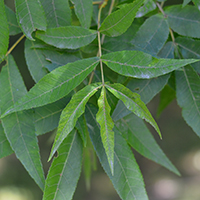What bitternut hickory looks like
Size and shape
- Grows 15 to 20 metres tall.
- Trunk reaches 30 to 80 centimetres in diameter.
Leaves
- Dark green leaves are 15 to 25 centimetres long.
- Have 7 to 11 long, pointed leaflets on a central stalk.
Bark
- Dark grey bark with shallow ridges.
Flowers
- Long, green catkins bloom in spring.
Fruit
- Round and bitter inedible nuts (2 to 3.5 centimetres long).
Where bitternut hickory is found
Bitternut hickory grows across Southern Ontario. It grows best in low, moist areas or in rich soil on higher ground. Because bitternut hickory grows well in shade, it is usually found among other trees.
What you need to know to grow bitternut hickory
- Moisture: grows best on very moist sites.
- Shade: tolerates partial shade but grows best in full sun.
- Soil: grows best in rich soils.
- Note: bitternut hickory trees need a lot of water in summer. Plant them in damp soil or water them as needed.
Benefits and uses of bitternut hickory
Wildlife benefits
Although they are not considered a preferred food source, some birds and small mammals eat bitternuts. Some small mammals also feed on bitternut hickory bark.
Commercial uses
Wood from bitternut hickory is strong, tough and shock resistant. It is used for:
- tool handles
- sports equipment, such as lacrosse sticks
- wheel spokes
Smoking with bitternut hickory wood gives meat a hickory flavour.
Fun facts about bitternut hickory
- Bitternut hickory belongs to a group of trees called pecan hickories.
- Bitternut hickory buds are a bright sulfur colour making them easy to identify.
- Bitternut hickory is the most widespread hickory in Canada.
Updated: January 10, 2024
Published: July 18, 2014




